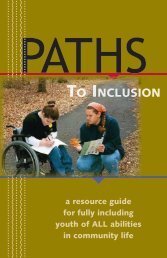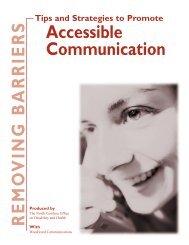Active Citizens 101 - National Service Inclusion Project
Active Citizens 101 - National Service Inclusion Project
Active Citizens 101 - National Service Inclusion Project
You also want an ePaper? Increase the reach of your titles
YUMPU automatically turns print PDFs into web optimized ePapers that Google loves.
Equality and Liberty, cont.<br />
HANDOUT 4.1 (C)-CIVIL RIGHTS LAWS<br />
PAGE 3<br />
is for rent. All the other tenants are Latino,<br />
and they feel like a big family. They want<br />
Luis to keep the building all Latino. One<br />
day, Sam Jung, an immigrant from Korea,<br />
comes to see the apartment. He wants the<br />
apartment because it is close to his work.<br />
Luis doesn't know what to say to him.<br />
Then he tells Sam Jung that he rented the<br />
apartment to somebody else. “What I told<br />
Mr. Jung wasn't true, and I feel bad. But I<br />
can't rent to a Korean family,” Luis tells his<br />
wife that night. “The other families wouldn't<br />
like it. Anyway, can't I decide It's my<br />
building.” Does this violate the law<br />
4. Southeast Electric Company has a fair<br />
hiring policy. They hire men and women<br />
and members of minority groups. But an<br />
employee must be 21 years old to work in<br />
the Control Room. Southeast says that the<br />
Control Room is dangerous. A person<br />
must know a lot about the computer and<br />
electrical systems and be very mature and<br />
responsible. Peter is 20 years old and has<br />
three years of experience working with<br />
computer and electrical systems at Southeast.<br />
His supervisor says Peter is very<br />
good at his work. The supervisor says Peter<br />
knows how to do the work in the Control<br />
Room. Peter says that Southeast's rule<br />
discriminates against him. Is Southeast<br />
Electric Company violating the law<br />
5. For many years, black students and<br />
white students went to segregated schools<br />
in the Parkwood School District. In the<br />
1950s, the court told the school district it<br />
could not have separate schools for blacks<br />
and whites. So the school district changed<br />
its rules. It did not say some schools were<br />
only for white children and some schools<br />
were for blacks. But black people and<br />
white people in Parkwood lived in different<br />
parts of town. The district changed the attendance<br />
areas so all children in white areas<br />
went to the same schools and children<br />
in the black areas went to other schools.<br />
Does this violate the law<br />
DRAFT<br />
39






